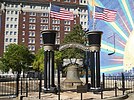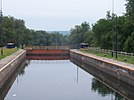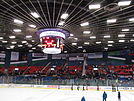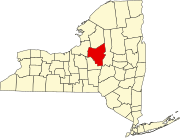Utica, New York
Utica, New York | |
|---|---|
City | |
| City of Utica | |
|
Clockwise from top: Panorama of downtown from I-790, Looking south on Utica's Genesee Street, Utica Harbor lock, Union Station, Utica Memorial Auditorium, Liberty Bell Corner, Stanley Theater | |
| Nickname(s): | |
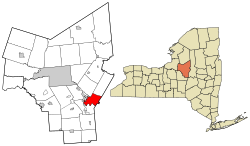 Location in Oneida County and New York | |
| Country | |
| State | |
| Metro | Utica–Rome |
| County | Oneida |
| Land grant (village) | January 2, 1734[3] |
| Incorporated (village) | April 3, 1798[4] |
| Incorporated (city) | February 13, 1832[5] |
| Government | |
| • Type | Mayor-council |
| • Mayor | Robert M. Palmieri (D) |
| Area | |
| • City | 43.0 km2 (16.6 sq mi) |
| • Land | 42.3 km2 (16.3 sq mi) |
| • Water | 0.7 km2 (0.3 sq mi) |
| Elevation | 139 m (456 ft) |
| Population (2010)[8] | |
| • City | 62,235 |
| • Estimate (2014[9]) | 61,332 |
| • Density | 1,471.3/km2 (3,818.1/sq mi) |
| • Urban | 117,328 (U.S.: 268th)[7] |
| • Metro | 296,615 (U.S.: 163rd)[6][a] |
| Demonym | Utican |
| Time zone | UTC-5 (Eastern (EST)) |
| • Summer (DST) | UTC-4 (EDT) |
| ZIP codes | 13500-13599 |
| Area code | 315 |
| FIPS code | 36-76540 |
| GNIS feature ID | 0968324[10] |
| Website | cityofutica.com |
Utica (pronounced /ˈjuːt[invalid input: 'ɨ']kə/ ) is a city in the Mohawk Valley and the county seat of Oneida County, New York, United States.[11] The tenth-most-populous city in New York,[12] its population was 62,235 in the 2010 U.S. census. On the Mohawk River at the foot of the Adirondack Mountains, Utica is approximately 90 miles (145 km) northwest of Albany[13] and 45 miles (72 km) east of Syracuse.[14] Although Utica and the neighboring city of Rome have their own metropolitan area, the cities are also represented and influenced by the commercial, educational and cultural characteristics of the Capital District and Syracuse metropolitan areas.[15][16]
Formerly a river settlement inhabited by the Mohawk tribe of the Iroquois Confederacy, Utica's immigrants strengthened its position as a layover city between Albany and Syracuse on the Erie and Chenango Canals and the New York Central Railroad. During the 19th and 20th centuries, the city's infrastructure contributed to its success as a manufacturing center and defined its role as a worldwide hub of the textile industry.[17][18] Utica's 20th-century political corruption and organized crime gave it the nicknames "Sin City"[19] and, later, "the city that God forgot."[20]
Similar to other Rust Belt cities, Utica's economic downturn has challenged it to recover from population loss to nearby suburbs, industrial decline due to globalization and poverty associated with socioeconomic stress and political problems.[21][22] With its low cost of living, the city has become a melting pot for refugees from war-torn countries around the world (encouraging growth for its colleges and universities, cultural institutions and economy).[23][24]
According to the 2010 census, the Utica–Rome Metropolitan Statistical Area (MSA) had 299,397 people in Oneida and Herkimer counties;[25] the counties in the Mohawk Valley have a combined population of 622,133.[b] In 2014, Utica's population was estimated at 61,332.
History
Utica (a village originally inhabited by the Mohawk people of the Iroquois Confederacy) was established on the site of Old Fort Schuyler, built in 1758 during the French and Indian War.[26][27][28][4] The land housing the fort was part of a 20,000-acre (80.94 km²) portion of marshland granted by King George II to New York governor William Cosby on January 2, 1734.[29] Since the fort was located near several trails (including the Great Indian Warpath), its position—on a bend at a shallow portion of the Mohawk River—made it an important fording point. The Mohawks called the bend Unundadages ("around the hill"), and the Mohawk word appears on the city's seal.[30][31][32]
During the American Revolution, border raids from British-allied Iroqouis tribes were used as an excuse to allow Rangers to enter Central New York and displace the Iroquois from their settlements.[32] The destruction of these villages and settlements allowed the arrival of settlers from New England.[33]
In 1794 a state road, Genesee Road, was built from Utica west to the Genesee River. That year a contract was awarded to the Mohawk Turnpike and Bridge Company to extend the road northeast to Albany, and in 1798 (the year the village was named and incorporated) it was extended.[34][4] The Seneca Turnpike was key to Utica's development, replacing a worn footpath with a paved road.[35] The village became a rest area on the Mohawk for goods and people moving through Western New York and the Great Lakes.[36][37]


Several theories exist about the etymology of the village's name.[38] Although surveyor Robert Harper claimed that he named the village "Utica",[38] the most accepted theory involves a 1798 meeting at Bagg's Tavern (a resting place for travelers passing through the village) where the name was picked from a hat with thirteen suggestions.[32][38] With the village's name chosen, its boundaries were defined in an act passed by the New York State Legislature on April 3, 1798.[39]
Utica expanded its borders in subsequent 1805 and 1817 charters. On April 5, 1805 the village's eastern and western boundaries were expanded,[40] and on April 7, 1817 Utica separated from Whitestown on its west.[4][41] The city's municipal charter was passed by the state legislature on February 13, 1832.[4][5] Its growth during the 19th century is indicated by the increase in its population; the United States Census ranked Utica as the 29th-largest in the country (with 20,000 residents) in 1845, more than the populations of Chicago, Detroit and Cleveland.[42][43]
Its location on the Erie and Chenango canals encouraged industrial development, allowing the transport of anthracite from northeastern Pennsylvania for local manufacturing and distribution.[44] Utica's economy centered around the manufacture of furniture, heavy machinery, textiles and lumber.[45] The combined effects of the Embargo Act of 1807 and local investment enabled further expansion of the textile industry.[46]

In addition to the canals, transport in Utica was bolstered by railroads running through the city. The first was the Mohawk and Hudson River Railroad, which became the Utica and Schenectady Railroad in 1833. Its 78-mile (126 km) connection between Schenectady and Utica was developed in 1836 from the right-of-way previously used by the Mohawk and Hudson River.[47][48] Later lines, such as the Syracuse and Utica Railroad, would merge with the Utica and Schenectady to form the New York Central Railroad, a 20th-century forest railway in the Adirondacks.[49]
With over 650 fugitive slaves during the 1850s, Utica played a major role in the Underground Railroad; the city was on a slave escape route from the Southern Tier to Canada by way of Albany, Syracuse and Rochester.[50][51] The route, used by Harriet Tubman to travel to Buffalo,[52] allowed slaves to pass through Utica on the New York Central Railroad right-of-way en route to Canada.[52] Utica was the locus for Methodist preacher Orange Scott's antislavery sermons during the 1830s and 1840s, and Scott formed an abolitionist group there in 1843.[51] Despite efforts by local abolitionists, pro-slavery riots and mobs forced many abolitionist meetings to other cities.[53]

The early 20th century brought rail advances to Utica, with the New York Central electrifying 49 miles (79 km) of track from the city to Syracuse in 1907 for its West Shore interurban line.[54] In 1902, the Utica and Mohawk Valley Railway connected Rome to Little Falls with a 37.5-mile (60.4 km) electrified line through Utica.[55]
At the time, Utica was known as "Sin City" because of the extent of its corruption at the hands of the Democratic Party political machine.[56][57][58][59] During the late 1920s, trucker Rufus Elefante rose to power[60][61] although he never ran for office.[62] Originally a Republican, Elefante's power was enhanced by support from New York governor Franklin D. Roosevelt.[63] Until the 1980s, the city had an organized crime presence.[59][64]

Utica, heavily affected by the deindustrialization also affecting other Rust Belt cities, experienced a major reduction in manufacturing activity during the second half of the 20th century. The 1954 opening of the New York State Thruway (which bypassed the city) and declines in activity on the Erie Canal and railroads throughout the United States also contributed to a poor local economy.[65] During the 1980s and 1990s, major employers such as General Electric and Lockheed Martin began to close plants in Utica and Syracuse.[66][67]
With city jobs moving to the towns and villages around Utica, suburbanization allowed the expansion of the nearby town of New Hartford and the village of Whitesboro. Utica's population fell, reflecting a statewide trend of decreasing urban populations outside New York City.[22]
Despite the city's economic decline it has benefited from a low cost of living,[68] attracting immigrants and refugees from around the world.[69][70][71] In 2010 Utica, the focus of local, regional and statewide economic-revitalization efforts,[72][73][74] developed its first comprehensive master plan in more than a half-century.[75][76]
Geography

According to the United States Census Bureau Utica has a total area of 16.6 square miles (43 km2), of which 16.4 square miles (42 km2) is land and 0.3 square miles (0.78 km2) (1.57 percent) water. The city is located at New York's geographic center, adjacent to the western border of Herkimer County, New York and at the southwestern base of the Adirondack Mountains.[77] Utica and its suburbs are bound by the Allegheny Plateau in the south and the Adirondack Mountains in the north,[78] and the city is 456 feet (139 m) above sea level.
Topography

The city's Mohawk name refers to its elevated position as seen from the Deerfield Hills in the north.[30] The Erie Canal and Mohawk River pass through northern Utica; northwest of downtown is the Utica Marsh, a group of cattail wetlands between the Erie Canal and Mohawk River (partially in the town of Marcy) with a variety of animals, plants and birds.[79][80] During the 1850s, plank roads were built through the marshland surrounding the city.[81] Utica's suburbs have more hills and cliffs than the city, and its position (where the Mohawk Valley forms a wide plain) gives much of the city a sloping, flat topography.[77]
Cityscape

Utica's architecture features many qualities also defining Buffalo, Rochester and Syracuse,[17] including Greek Revival, Italianate, French Renaissance,[82] Gothic Revival and Neoclassical styles. The modernist 1972 Utica State Office Building, at 17 floors and 227 feet, is the city's tallest.[83]
With no master plan for the city, early settlers and property owners contributed to its layout and many families and individuals are remembered in street names.[84] Streets laid out when Utica was a village had more irregularities than those built later in the 19th and 20th centuries. As a result of the city's location (adjacent to the Mohawk), it is offset; not all streets run north-south or east-west. Remnants of Utica's early electric-rail systems can be seen in the West and South neighborhoods, where they ran on the streets.[85][30][86]
Neighborhoods

Utica's neighborhoods have historically been defined by their residents, allowing them to develop their own individuality.[43] Racial and ethnic groups, social and economic separation and the development of infrastructure and new means of transportation have shaped neighborhoods, with groups shifting between them as a result.
West Utica (or the West Side) was historically home to German and Irish immigrants, and the Corn Hill neighborhood in the city center had a significant Polish and Jewish population.[87] East Utica (or the East Side) is a cultural and political center dominated by Italian immigrants.[88][89] North of downtown is the Triangle neighborhood, home to the city's African American and Jewish populations. Neighborhoods formerly dominated by one or more groups saw other groups arrive, such as Bosnians and Latin Americans in former Italian neighborhoods and the Welsh in Corn Hill.[43] Bagg's Square and Bagg's Square West (Utica's historic centers) are in the northeastern portion of downtown, with Genesee Street on the west and Oriskany Street on the south.[82]
Climate
Template:Utica climate chart Utica has a continental climate with four distinct seasons and is in the humid continental climate (or warm-summer climate: Köppen Dfb)[90][91] zone, characterized by cold winters and temperate summers. Summer daytime temperatures range from 70–82 °F (21-28 °C), with an average winter daytime temperature below -3 °C (27 °F).[91] The city is in USDA plant hardiness zone 5a, and native vegetation can tolerate temperatures from -10 °F to -20 F (-28.9 °C to -26.1 °C).[92]
Summer high temperatures are generally between 75 °F (24 °C) and 85 °F (29 °C), with days below 70 °F (21 °C) common. On summer nights, the temperature generally drops to 50–60 °F (10–16 °C).
Winters are cold and snowy, due to lake-effect snow from Lakes Erie and Ontario.[93][94][95] Utica is colder on average than other Great Lakes cities, due to its location in a valley and susceptability to north winds;[96] temperatures in the single numbers or below zero Fahrenheit are not uncommon on winter nights. The city's record low temperature was -28 °F (-33 °C),[97] recorded February 18, 1979 and January 12, 1981.[97] Its record high was 100 °F (38 °C), recorded on July 19, 1953. Annual precipitation (based on a 30-year average from 1981–2010) is 42.1 inches (1,069 mm), falling on an average of 171 days.[98]
Demographics

| Census | Pop. | Note | %± |
|---|---|---|---|
| 1850 | 17,565 | — | |
| 1860 | 22,529 | 28.3% | |
| 1870 | 28,804 | 27.9% | |
| 1880 | 33,914 | 17.7% | |
| 1890 | 44,007 | 29.8% | |
| 1900 | 56,383 | 28.1% | |
| 1910 | 74,419 | 32.0% | |
| 1920 | 94,156 | 26.5% | |
| 1930 | 101,740 | 8.1% | |
| 1940 | 100,518 | −1.2% | |
| 1950 | 100,489 | 0.0% | |
| 1960 | 100,410 | −0.1% | |
| 1970 | 91,611 | −8.8% | |
| 1980 | 75,632 | −17.4% | |
| 1990 | 68,637 | −9.2% | |
| 2000 | 60,523 | −11.8% | |
| 2010 | 62,235 | 2.8% | |
| 2014 (est.) | 61,332 | [9] | −1.5% |
| U.S. Decennial Census[99] | |||
Although Utica's population is predominately Caucasian, it has diversified since the 1990s with the addition of immigrants and refugees (particularly Bosnian Americans, displaced by the Bosnian War);[100] over 15 languages are spoken in the city.[101] Utica has a low cost of living, due to its industrial and economic decline. The city is the tenth-most-populous in New York, the seat of Oneida County and (with Schenectady) a focal point of the six-county Mohawk Valley region. According to a U.S. Census estimate, the Utica–Rome Metropolitan Statistical Area decreased in population from 299,397 in 2010 to 296,615 on July 1, 2014[12] and its population density was 3,818.1 people per square mile (1,471.3/km²).
In the 2010 United States Census Utica's population was 62,235, of which 69 percent were Caucasian, 64.5 percent non-Hispanic white, 15.3 percent African American and 0.3 percent American Indians and Alaska Natives. Asians were 7.4 percent of the city's population (3.5 percent Burmese, 1.5 percent Vietnamese, 0.7 percent Cambodian, 0.4 percent Indian, 0.2 percent Chinese, 0.2 percent Korean, 0.1 percent Japanese, 0.3 percent other Asian),[102] Native Hawaiians and Pacific Islanders were 0.1 percent and Hispanics or Latinos of any race were 10.5 percent (6.8 percent Puerto Rican, 1.5 percent Dominican, 0.4 percent Mexican, 0.3 percent Salvadoran, 0.2 percent Ecuadoran, 0.1 percent Cuban and 0.9 percent other Hispanic or Latino).[103] Other races were 3.9 percent, and multiracial individuals made up four percent of the population.
Median income for a Utica household was $24,916, and median income for a family was $33,818. Men had a median income of $27,126, and the median income for women was $21,676. Per capita income was $15,248, and 19.8 percent of families and 24.5 percent of the population were below the poverty threshold (including 38 percent of those under 18 and 12.1 percent of those 65 and over).
| Racial composition | 2010 [25] | 1990[104] | 1970[104] | 1950[104] |
|---|---|---|---|---|
| White | 69.0% | 86.7% | 94.1% | 98.4% |
| —Non-Hispanic | 64.5% | 84.8% | 91.2% | n/a |
| African American | 15.3% | 10.5% | 5.6% | 1.6% |
| American Indians and Alaska Natives | 0.6% | 0.3% | 0.2% | n/a |
| Hispanic or Latino (of any race) | 10.5% | 3.4% | 0.9%[c] | n/a |
| Asian | 7.4% | 1.1% | 0.1% | n/a |
| Other race | 3.9% | 1.5% | 0.1% | n/a |
| Two or more races | 4.0% | n/a | n/a | n/a |
Economy

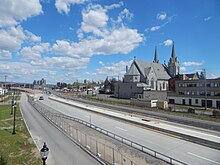
During the mid-19th century, Utica employed its canals and railroads for industries producing furniture, locomotive headlights, steam gauges, firearms, textiles and lumber.[45][82] World War I sparked the growth of Savage Arms, which produced the Lewis gun for the British Army,[105] and the city was one of the wealthiest per capita in the United States.[106]

After the rapid decline of the local textile industry during the early 20th century, Utica's economy was dependent on electronics manufacturing (led by companies such as General Electric, which produced transistor radios),[107] machinery and equipment and food processing.[108] During the second half of the century, the city's recessions were longer than the national average.[109] The exodus of defense companies (such as Lockheed Martin, formed from the merger of the Lockheed Corporation and Martin Marietta in 1995) and the electrical-manufacturing industry played a major role in Utica's economic stress.[109] From 1975 to 2001 the city's economic growth rate was similar to that of Buffalo, with other upstate New York cities such as Rochester and Binghamton outperforming both.[109]
The Mohawk Valley economy is currently based on logistics, industrial processes, machinery and industrial services.[110] In Rome, the former Griffiss Air Force Base has remained a regional employer as a technology center. The Turning Stone Resort & Casino in Verona is a tourist destination, with a number of expansions during the 1990s and 2000s.[111]
Utica's larger employers include the ConMed Corporation (a surgical-device and orthotics manufacturer)[112] and Faxton St. Luke's Healthcare, the city's primary healthcare system.[113] Construction, such as the North-South Arterial Highway project, supports the public-sector job market.[114] Although passenger and commercial traffic on the Erie Canal has declined since the 19th century, the barge canal has allowed heavy cargo to travel through Utica (bypassing the New York State Thruway and providing intermodal freight transport with the railroads).[115]
Law, government and politics
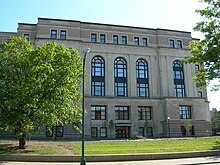
Republican Robert M. Palmieri, elected in 2012, is Utica's current mayor.[116] The common council consists of ten members, six of whom are elected from single-member districts. The other four, including its president, are elected at-large.[117] The council has eight standing committees for issues including transportation, education, finance and public safety.[118] Utica is in New York's 22nd congressional district, which has been represented by Republican Richard L. Hanna since 2013. There is a relative balance between the Democratic and Republican parties, a change from the predominantly single-party politics of the 20th century.[119]
According to the comptroller's office, in 2014 Utica's governmental expenses totaled $79.3 million (a net increase of $940,000 from the previous year).[120] The 2015-2016 budget proposes general-fund spending of $66.3 million.[121] City taxes collected in 2014 were $25,972,930, with a tax rate per thousand of $25.24.[121] Utica is served by the United States District Court for the Northern District of New York, with offices in the Alexander Pirnie Federal Building.[122]
Crime and public safety
Template:Utica crimebox According to the city's police department, there were seven murders, 102 robberies, 27 rapes and 225 assaults in 2013 (a decrease from the previous year, representing a violent-crime rate of 0.6 percent). There were 432 burglaries, 1,826 larcenies and 108 motor-vehicle thefts (a decrease from 2013, representing a property-crime rate of 4.1 percent). Total crimes in 2014 were 2,755 (a decrease from the previous year, with an overall crime rate of 4.7 percent). Compared to other cities in New York, Utica's crime rate is generally low.[123][124] The Utica Police Department patrols the city, and law enforcement is also under the jurisdiction of the Oneida County Sheriff's Office and the New York State Police.[125] The Utica Fire Department coordinates four engine and two truck companies, rescue, HAZMAT and medical operations with a 123-person crew.[126]
Culture


Utica's position in the northeastern United States has allowed the blending of cultures and traditions. The city shares characteristics with other cities in Central New York, including its dialect (Inland Northern American English, also present in other Rust Belt cities such as Buffalo, Elmira and Erie, Pennsylvania).[127]
Utica shares a cuisine with the mid-Atlantic states, with local and regional influences. The city's melting pot of immigrant and refugee cuisines,[128] including Dutch, Italian, German, Irish and (more recently) Bosnian,[69] have introduced dishes such as ćevapi and pasticciotti[nb 1] to the community.[131][132] Utica staple foods include Utica riggies,[133] Utica greens,[134] half-moons[135][136] and tomato pie.[137] Other popular dishes are pierogi, penne alla vodka and sausage and peppers.[138][139] Utica is rooted in the brewing industry, with the family-owned Matt Brewing Company ranked the 15th-largest brewery in the United States in 2012 by sales.[140][141]
The annual 15-kilometre (9.3 mi) Boilermaker Road Race, organized by the city in conjunction with the National Distance Running Hall of Fame, attracts runners from the region and around the world, including Kenya and Romania.[142][143] The Children's Museum of Natural History, Science and Technology, next to Union Station, opened in 1963. In 2002 the museum partnered with NASA, featuring exhibits and events from the agency.[144][145] The Munson-Williams-Proctor Arts Institute (founded in 1919) features a PrattMWP program in cooperation with Pratt Institute, permanent collections and rotating exhibits.[146]

The Utica Psychiatric Center, formerly a Greek Revival insane asylum, was the birthplace of the Utica crib (a restraining device frequently used at the asylum from the mid-19th century to 1887.[38][148][149][150] The Stanley Center for the Arts, a mid-sized concert and performance venue, was designed by Thomas W. Lamb in 1928 and features theatrical and musical performances by local and touring groups.[151] The restored Hotel Utica, designed by Esenwein & Johnson in 1912, had become a nursing and residential-care facility until the mid-1970s;[152] notable guests included Franklin D. Roosevelt, Judy Garland and Bobby Darin.[153][154]
Sports

Utica is home to the Utica Comets, affiliated with the National Hockey League's Vancouver Canucks. Formerly the Peoria Rivermen, the team moved to Utica and began playing in the American Hockey League during the 2013–14 season.[155][156] The 3,815-seat Utica Memorial Auditorium, which opened in 1960, is home to the Comets and the Utica College Pioneers. The Utica Devils played in the AHL from 1987 to 1993, and the Utica Bulldogs (1993–94), Utica Blizzard (1994-97) and Mohawk Valley Prowlers (1998-2001) were members of the United Hockey League (UHL).[157]
The city was home to the Utica Blue Sox (1939-2001), a New York–Penn League baseball team also affiliated with the Toronto Blue Jays and, later, the Miami Marlins. Other former baseball teams included the Utica Asylums (1900) and the Boston Braves-affiliated Utica Braves (1939–42).[158]
Area collegiate teams
| School | Nickname | Colors | Association | Conference |
|---|---|---|---|---|
| SUNY Polytechnic Institute | Wildcats | Blue and gold | NCAA Division III | NEAC |
| Hamilton College | Continentals | Buff and blue | NCAA Division III | NESCAC |
| Utica College | Pioneers | Navy and orange | NCAA Division III | Empire 8 |
| Mohawk Valley Community College | Hawks | Sea green and gray | NJCAA | Region III |
| Herkimer County Community College | Generals | Hunter green and gold | NJCAA | Region III |
Parks and recreation

Utica's park system has 677 acres (274 ha) of parks and recreation centers; most of the city's parks have community centers and swimming pools.[10] Frederick Law Olmsted, Jr. (who designed New York City's Central Park and Delaware Park in Buffalo) designed the Utica Parks and Parkway Historic District, a national historic district.[159] Olmsted also designed Memorial Parkway, a 4-mile (6.4 km) tree-lined boulevard connecting the district's parks and encircling the city's southern neighborhoods.[160][161] The district includes Roscoe Conkling Park, F.T. Proctor Park, the Parkway and T.R. Proctor Park.[162][163]
The city's municipal golf course, Valley View (designed by golf-course architect Robert Trent Jones), is south of the city near the village of New Hartford.[10] The Utica Zoo and the Val Bialas Ski Chalet, an urban ski slope featuring skiing, snowboarding, outdoor skating and tubing, are also south of the city in Roscoe Conkling Park.[164] Smaller neighborhood parks in the district include Addison Miller Park, Chancellor Park, Seymour Park and Wankel Park.[165]
Education

Like Ithaca and Syracuse, Utica has a mix of public and private colleges and universities; three state colleges and four private colleges are in the Utica–Rome metropolitan area. SUNY Polytechnic Institute, on an 850-acre campus in North Utica and Marcy, has over 2,000 students[166] and is one of eight technology colleges and 14 doctorate-granting universities of the State University of New York (SUNY).[167][168] Mohawk Valley Community College, the largest college between Syracuse and Albany with nearly 7,000 students,[169] and an Empire State College location serve Utica and Rome.

Formerly a satellite campus of Syracuse University, Utica College is a four-year private liberal arts college with over 3,000 students.[170] Established in 1904, St. Elizabeth College of Nursing partners with regional institutions to grant nursing degrees.[171] Pratt Institute offers a local two-year fine-arts course,[172] and the Utica School of Commerce has business-related programs at its Central New York locations.[173]
The Utica City School District had an enrollment of nearly 10,000 in 2012.[174] District schools include Thomas R. Proctor High School, James H. Donovan Middle School and twelve elementary schools. Utica's original public high school, the Utica Free Academy, closed in 1987.[175] The city is also home to Notre Dame Junior Senior High School, a small Catholic high school founded in 1959 by the Xaverian Brothers.[176]
Media

Utica is served by five stations affiliated with major television networks, including WKTV (NBC), WUTR (ABC), WFXV (Fox) and WKTV-DT2 (CW). WTVH, Syracuse's CBS affiliate, is the city's de facto CBS station.[15] PBS affiliate WCNY-TV in Syracuse operates translator W22DO-D on analog channel 22 and digital channel 24. Several low-power television stations, such as WPNY-LP (MyNetworkTV), also broadcast in the area. Cable television viewers are served by the Syracuse office of Time Warner Cable, which offers a local news service, a local sports channel and public-access channels.[177] Dish Network and DirecTV provide satellite television customers with local broadcast channels.[178][179]
Utica's main daily newspaper is the Observer-Dispatch; the Utica Phoenix, established in 2002, is an alternative.[180] The city has 26 FM radio stations and nine AM stations. Major station owners in the area include Townsquare Media and Galaxy Communications. In addition to minor popular-culture references,[181][182][183][184] Slap Shot (1977) was partially filmed in Utica and the city has been featured on The Office.[183][185][186]
Infrastructure
Transportation


Griffiss International Airport in Rome primarily serves military and general aviation, and regional, domestic and international passenger air travel in the Utica–Rome metropolitan area is provided from Syracuse Hancock International Airport and Albany International Airport.[187] Amtrak's Empire, Maple Leaf and Lake Shore Limited trains stop at Utica's Union Station. Bus service is provided by the Central New York Regional Transportation Authority (CENTRO), a Syracuse public transport operator which runs twelve lines in Utica and has a downtown hub.[188] Intercity bus service is provided by Greyhound Lines and the Birnie Bus Company, with weekday and Saturday service to Syracuse;[189] both stop at Union Station.[190][191]

During the 1960s and 1970s, New York state planners envisioned a system of arterial roads in Utica which would include connections to Binghamton and Interstate 81.[192] Due to community opposition[193] only parts of the highway project were completed, including the North–South Arterial Highway running west of the city.[192][194] Of Utica's highway network, six New York State highways, one three-digit interstate highway and one two-digit interstate highway pass through the city. New York State Route 49 and New York State Route 840 are east-west expressways running along Utica's northern and southern borders, respectively, with the eastern terminus of both in the city. New York State Route 5 and its alternate routes, New York State Route 5S and New York State Route 5A, are east-west roads and expressways which pass through Utica; NY 5S's western terminus is in the city. With NY 5 and Interstate 790 (an auxiliary highway of Interstate 90), New York State Route 12 and New York State Route 8 form the North–South Arterial Highway.
Utilities

Electricity in Utica is provided by National Grid plc, a British energy corporation which acquired the city's former electricity provider (Niagara Mohawk) in 2002.[195] Utica is near the crossroads of major electrical-transmission lines,[196] with substations in the town of Marcy. An expansion project by the New York Power Authority, National Grid, Consolidated Edison and New York State Electric and Gas (NYSEG, a subsidiary of Iberdrola USA) is planned.[197][198] In 2009 city businesses (including Utica College and St. Luke's Medical Center) developed a microgrid, and in 2012 the Utica City Council explored the possibility of a public, city-owned power company.[199][200][201] Utica's natural gas is provided by National Grid[202] and NYSEG.[203][204]
Municipal solid waste is collected and disposed of weekly by the Oneida-Herkimer Solid Waste Authority,[205] a public-benefit corporation which coordinates single-stream recycling, waste reduction, composting and the disposal of hazardous materials and demolition debris.[206] Utica's wastewater is treated by the Mohawk Valley Water Authority, with a capacity of 32 million gallons per day.[207][208] Treated water is tested for impurities including pathogens, nitrates and nitrites.[207] Utica's drinking water comes from the stream-fed Hinckley Reservoir in the foothills of the Adirondack Mountains.[208]
Healthcare
Primary health care in Utica is provided by the Mohawk Valley Health System, a nonprofit organization which operates Faxton St. Luke's Healthcare and St. Elizabeth Medical Center.[209] The St. Luke's and Faxton hospitals have a total of 370 acute and 202 long-term beds, and St. Elizabeth has 201 acute-care beds.[210] St. Luke's and Faxton are surgical centers, and St. Elizabeth is a trauma and surgical center.[209]
Notable residents
-
Annette Funicello (1942-2013), actress[211]
-
Robert Esche, NHL hockey player and sports executive[212]
See also
- Lower Genesee Street Historic District
- Utica Shale – a geological formation named for Utica
- Timeline of town creation in Central New York
Notes
- ^ Estimated MSA rank as of July 1, 2014.
- ^ Calculated from the total populations of Oneida, Herkimer, Schenectady, Otsego, Fulton, and Montgomery counties as of the 2010 census.
- ^ Population estimate from a 15-percent sample
References
Bibliography
- Bagg, M. M. (1892). Memorial history of Utica, N.Y.: from its settlement to the present time. Cornell University Library: D. Mason & Co. Publishers. OCLC 1837599.
{{cite book}}: Invalid|ref=harv(help) - Bottini, Joseph P.; Davis, James L. (2007). Utica. Arcadia Publishing. ISBN 978-0-7385-5496-9.
{{cite book}}: Invalid|ref=harv(help) - Childs, L. C. (1900). Outline History of Utica and Vicinity. New Century Club, Utica, New York. OCLC 1558992.
{{cite book}}: Invalid|ref=harv(help)CS1 maint: location missing publisher (link) - R. Thomas, Alexander (2003). In Gotham's Shadow. State University of New York Press. ISBN 978-0-7914-5595-1.
{{cite book}}: Invalid|ref=harv(help) - R. Thomas, Alexander; Smith, Polly J. (2009). Upstate Down: Thinking about New York and Its Discontents. University Press of America. ISBN 978-0-7618-4500-3.
{{cite book}}: Invalid|ref=harv(help) - Switala, William J. (2006). Underground Railroad in New Jersey and New York. Stackpole Books. ISBN 978-0-8117-3258-1.
{{cite book}}: Invalid|ref=harv(help)
Further reading
- Bartholomew, Harland (1921). A preliminary report on major streets, Utica, New York. Willard Press. OCLC 682139143.
- Bean, Philip A. (2004). La Colonia: Italian Life and Politics in Utica, New York, 1860-1960. Utica College, Ethnic Heritage Studies Center. ISBN 978-0-9660-3630-5.
- Bean, Philip A. (2010). The Urban Colonists: Italian American Identity and Politics in Utica, New York. Syracuse University Press. ISBN 978-0-8156-3238-2.
- Hopper, Wilbert Clayton (1933). The marketing of fruits and vegetables in the city of Utica. New York State College of Agriculture. OCLC 63975458.
- Ferris, T. Harvey (1913). Utica, the heart of the Empire state. Library of Congress. ASIN B00486TJ2C.
- Kobryn, Nancy (1995). Guts and glory, tragedy and triumph: the Rufus P. Elefante story. Steffen Pub. OCLC 40756638.
- Pula, James S. (1994). Ethnic Utica. Ethnic Heritage Studies Center, Utica College of Syracuse University. ISBN 978-0-9668-1785-0.
- Shumway, Daniel (2014). Utica Beer: A History of Brewing in the Mohawk Valley. The History Press. ISBN 978-1-6261-9338-3.
- Utica Public Library (1932). A bibliography of the history and life of Utica; a centennial contribution. Goodenow Print. Co. OCLC 1074083.
- Webster, Dennis; Peck, Bernadette (2014). Haunted Utica: Mohawk Valley Ghosts and Other Historic Haunts. The History Press. ISBN 978-1-6258-4593-1.
External links
- NYPL Digital Gallery. Items related to Utica, NY, various dates
- Library of Congress, Prints & Photos Division. Items related to Utica, NY, various dates
- SkyscraperPage. Diagram of skyscrapers in Utica, NY, various dates
- Utica, NY at DMOZ
 Utica travel guide from Wikivoyage
Utica travel guide from Wikivoyage The full text of The American Cyclopædia (1879)/Utica (New York) at Wikisource
The full text of The American Cyclopædia (1879)/Utica (New York) at Wikisource



